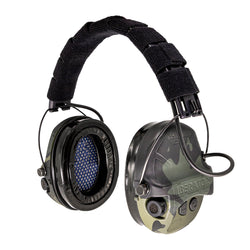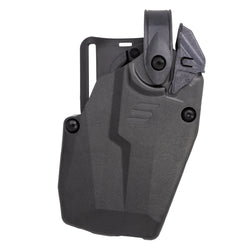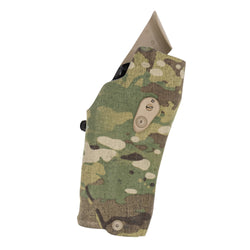The patrol rifle concept has ebbed and flowed with the changing needs of law enforcement and the public attitudes that shape it. With the risk of going toe to toe with armored active shooters on the rise after Columbine, the favored long arm of law enforcement, the shotgun, has declined in favor of carbines like the AR-15. In truth, rifles were long a favorite in law enforcement, but attitudes towards patrol rifles were mum for much of the 20th century, when the shotgun reigned.

Rifles were a preferred choice of deputies, marshals, and coppers from the Wild West well into the 1930s, when the FBI and other agencies systematically chased down motor bandits like Bonnie and Clyde and John Dillinger. But as police work grew more urbanized, the ease of use and limited reach of the shotgun had more appeal. Over time, rifles gained more militaristic connotations, while the familiar and capable shotgun was retained as part of the image of the civilian peace officer.
But advancement in ammunition and rifle tactics have since come a long way, and the rifle gives the user options they would not otherwise have with a shotgun or a handgun. We know that now, and clearly, law officers at the turn of the century understood it as well. That era was tamed by the likes of the Winchester 94, the Remington Model 8, and first and foremost, the Winchester 1873.
History of the Winchester 1873
At the start of American policing, the average officer was primarily armed with a billy club and whatever pocket handgun his meager salary could afford. There were no standard-issue firearms, largely due to fear of damaging community relations. But rising crime and the reality of an armed society forced change. In 1857, the Baltimore Police Department became the first to officially arm its officers.
Small, pocket-sized .32 caliber handguns were the first choice in the East, but the West was the proving ground for more substantial arms. As it happened, the 1860s and 1870s were a time of quantum leaps in gun technology, with the shift from muzzleloaders to cartridge-firing models.

Model 1860
The Henry Model 1860 was the first leap in rifle technology. It was a breech-loading lever-action rifle that held sixteen rounds of .44 Henry Flat ammunition. The .44 Henry was not particularly powerful against a rifled musket, but the ability to reload with the flick of a wrist and have sixteen rounds ready to go was a game-changer.
Though the Henry saw limited use in the Civil War, Oliver Winchester recognized its potential and bought an interest in the company post-war. But the rifle’s inventor, Benjamin Tyler Henry, was not keen on addressing some of its shortcomings. Winchester engineered the takeover of the company and empowered his engineers to make those improvements.
Model 1866
The result was the Model 1866. It featured a separate and sealed magazine and the King’s Patent loading gate, which allowed for quick top-offs while in use. It still chambered the .44 Henry Flat—a rimfire cartridge—but a more powerful centerfire option was in the works when the Winchester 1873 debuted.

Model 1873
The Model 1873 retained the loading gate and tubular magazine setup of its predecessor, but added a steel receiver and a new cartridge: the new .44 WCF cartridge, also known as .44-40. It fired a 200-grain bullet backed by 40 grains of black powder. It is more powerful than .45 Colt and most handgun cartridges available, but it is what we would still call a pistol cartridge today.
That point was driven home when Colt and Smith & Wesson began chambering their flagship revolvers in the round. The Winchester 73 in .44-40 became something of the first universal carbine, particularly when paired with a revolver in the same caliber.
Although .44-40 was the most popular chambering, the 1873 was also offered in .25-20, .32-20, and .38-40. Barrel lengths and stock configurations varied widely, from 16-inch Trapper carbines to 26-inch Sporting Rifles. All featured double-digit capacity and could be fired as quickly as the lever could be cycled and the trigger pulled.
The Winchester 73 was eventually superseded by the Browning-designed Winchester 1892. While the 1892 fired the same cartridges, it featured a stronger locking action for smokeless powder. Still, the 73 remained in production until 1919, with over 700,000 units produced. Since then, Italian-made versions by Uberti have brought the platform back, and in 2013, Winchester resumed production of the rifle once again.
Shooting and Handling the Modern 1873: Cimarron’s Indian Territory Marshal
Modern renditions of the Winchester 1873 are as varied now as they were during their original run. Barrel lengths run the gamut, full pistol grip and straight grip options, and calibers range from .32-20 Winchester all the way up to .45 Colt and .44 Magnum.
Cimarron’s US Marshal Indian Territory (IT) Carbine is a perfect example of the model at its most practical for patrol, but it also has its foot in history. This variation of the 1873 was issued to US Marshals roaming the Indian Territory (later Oklahoma) by the infamous Hanging Judge Isaac Parker in 1880.

The standard short rifle version of the 1873 has a 20-inch barrel and a full-length stock. This one has a shorter buttstock and an 18-inch barrel. The IT Marshal version features a non-slip crescent butt plate and uncheckered walnut stocks. While some early 1873s featured a case-hardened receiver, this rifle has the more typical deep blue finish on the receiver and the barrel.

Ergonomically, the 1873 is a well-appointed rifle with some features that would later carry over into future patrol rifles. The rifle has a case-hardened lever and trigger as well as a sliding brass elevator that feeds ammunition from the tubular magazine.
The front sight is a non-removable post paired with a rear notch ladder sight. When folded flat, the battle sight is nominally zeroed to 100 yards. With the ladder raised, the sight can be graduated from 200-800 yards. Those latter distances were more intended for engaging threats at a standoff distance as part of a group. Still, the IT Marshal is available in .357 Magnum, .44 Magnum, and .45 Colt, all of which are feasible out to 200 yards.
At eye level, the sights are very pistol-like and pop out for close-range snap shooting. A more precise sight picture was often achieved with the mounting of a peep rear sight like those from Marbles and Lyman.

Two unappreciated aspects of the 73 Winchester carbines are the inclusion of a saddle ring and a dust cover. The saddle ring mounted to the left side of the receiver was intended to retain the rifle while on horseback, and, in effect, it is a single-point sling attachment. The dust cover, manually thumbed over the elevator and bolt, prevents mud and sand from getting into the action. Cycling the action automatically kicks the dustcover back, and empty brass is free to eject.

My particular IT Marshal is chambered in .357 Magnum. It holds ten rounds of .357 or eleven rounds of shorter .38 Special ammunition. Ammunition was provided by Ammunition to Go. The diet includes:
- .38 Special Federal Hydra-shock 129 grain +P
- .38 Special Federal 158 grain +P LSWHP
- .38 Special Hornady Critical Defense 110 grain FTX
- .357 Magnum Hornady LeverEvolution 140 grain FTX
- .357 Magnum PMC Bronze 158 grain SP
Loading the 1873 was a pinch at first. At first, the new magazine spring made loading a chore, I was able to load and top off through the loading gate without any issue.
Once the magazine is loaded, the rifle can be racked, the dustcover closed, and the hammer dropped and pulled into the half-cock position to render it safe to carry. The lever can also be locked to keep it from hanging loose in your grip. The rifle will fire when the lever is locked, but you have to remember to take off the lock for any repeat firing.

Shooting rifles like the 1866 and 1873 Winchesters is about as close as it gets to running a semi-auto with a lever gun. The toggle locking action is sufficient for magnum handgun cartridges, but little more. What you get in exchange is an action that is effortless to run, with the only friction point being that the bolt still has to kick the hammer back with every shot. Combine this with the 1873’s pistol-like sights, and it is not only fast to shoot but fast to meet targets at distances under 50 yards.
The IT Marshal balances just under the receiver and is easy to swing like any other Winchester carbine. At 100 yards, the stock sights proved to be more of a challenge for getting groups. As it happens, rifles like these tend to shoot a little high at 50 yards and right on at 100.
From the prone position, I could get five rounds of generic PMC Bronze .357 Magnum ammo into a group that measures a little over two inches. To put that into perspective, the DOD mandates milspec accuracy requirements of the M4 platform at 5 inches at 100 yards with iron sights. All things considered, not a bad showing from the very first patrol rifle—unrivaled in history, and still no slouch despite the advances we have made.











